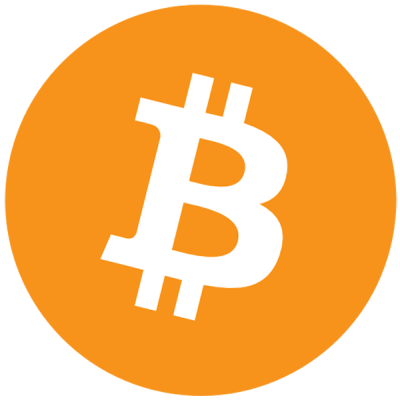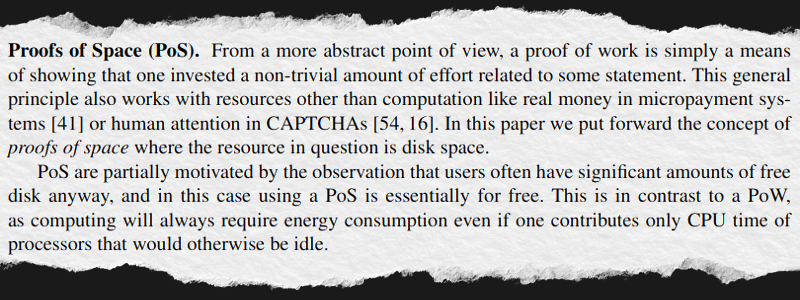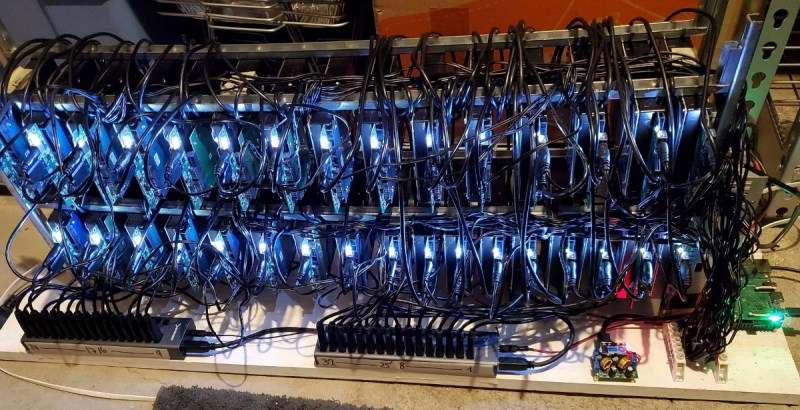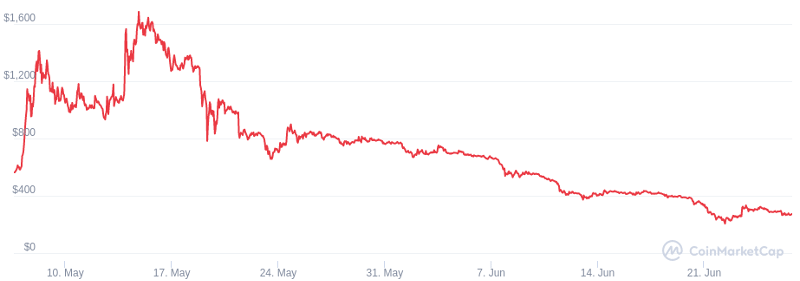Whomever Who Dies With His Art on the Most Hard Drives Wins
At this point the boilerplate Hackaday reader is likely familiar with so-chosen "Proof of Work" (Pow) cryptocurrencies, such equally Bitcoin, Ethereum, and Dogecoin. In the most basic of terms, these cryptocurrencies allow users to earn money past devoting computational power to the network. Unfortunately, information technology'south well past the point where your standard desktop CPU is moving enough bits to earn annihilation worthwhile. Individuals looking to turn a profit have therefore resorted to constructing arrays of high-terminate graphics cards for the express purpose of "mining" their cryptocurrency of choice.
 These miners, combined with ongoing chip shortages, have ravaged the GPU market. Anyone who's looked at building or upgrading a computer recently volition know that new video cards are in short supply, and even old models that would otherwise be considered upkeep options, are commanding outrageous prices. In an effort to appease their core customers, NVIDIA has even introduced cryptocurrency-specific cards that lack video output. The hope was that professional miners would buy these Cryptocurrency Mining Processors (CMPs) instead of the traditional video cards, freeing upward the latter for purchase by gamers. But due to the limited availability and relatively loftier cost of CMPs, they've done niggling to amend the situation.
These miners, combined with ongoing chip shortages, have ravaged the GPU market. Anyone who's looked at building or upgrading a computer recently volition know that new video cards are in short supply, and even old models that would otherwise be considered upkeep options, are commanding outrageous prices. In an effort to appease their core customers, NVIDIA has even introduced cryptocurrency-specific cards that lack video output. The hope was that professional miners would buy these Cryptocurrency Mining Processors (CMPs) instead of the traditional video cards, freeing upward the latter for purchase by gamers. But due to the limited availability and relatively loftier cost of CMPs, they've done niggling to amend the situation.
Now if yous don't use your figurer for gaming, this probably seems like a distant problem. You could even be forgiven for thinking of this as trivial more than two largely frivolous pursuits at loggerheads with each other. After all, in a customs that still holds decades-onetime Thinkpads as the high h2o marker in portable computing, a certain ambiguity about cut edge video cards is perchance to be expected.
But there's a new class of cryptocurrency on the rise which threatens more than just the hardcore gamers. With "Proof of Infinite" (PoS) cryptocurrencies, information technology'southward non about having the fastest CPU or the highest number of GPUs; the article being traded is storage space, and the player with the most hard drives wins.
The Rising of Chia
Conceptually, PoS cryptocurrencies have been around for some time. The idea was commencement proposed in the 2013 newspaper "Proofs of Space" by Stefan Dziembowski, Sebastian Faust, Vladimir Kolmogorov, and Krzysztof Pietrzak, which was afterwards presented at the 35th International Cryptology Conference in 2015. The core argument of the paper is that PoW currencies are inherently wasteful as they consume processing power to function, and notes that critics were already predicting Bitcoin would exist an environmental disaster. By comparison, the difference in energy consumption between an idle reckoner and one running their hypothetical PoS software would be negligible. Further, they reasoned that computers already had a large corporeality of unused deejay space that could exist offered up to the network.

A few cryptocurrencies did emerge based on the concepts laid out in "Proofs of Space", but none of them really defenseless on until the Chia Network was founded in 2017. Cheers at to the lowest degree in office to investors eager to get into anything involving blockchain engineering, the startup sailed to a valuation of $500 one thousand thousand in May of this year. Created by BitTorrent developer Bram Cohen, the documentation for Chia leans heavily into the idea that information technology's the "green" culling to Bitcoin, requiring neither a loftier-performance computer nor any equipment that couldn't be readily reused if you lot were no longer interested in Chia. As explained in their FAQ, naught stops you from deleting the Chia information from your drives and using them for regular file storage.
 At least on newspaper, Chia certainly seems like the more eco-friendly choice. Consider that a mod high-terminate video carte du jour like the GeForce RTX 3080 tin can easily pull more than 300 watts when running at full tilt, while even the most power hungry SSDs top out at 8 watts. Of course that doesn't take into business relationship the cost of the hardware, or the relative value of each resource as measured by their respective cryptocurrencies. But if your simply concern is how many watts your system is drawing, y'all could spin up 20 or 30 SSDs before they even got close to what a modern GPU consumes.
At least on newspaper, Chia certainly seems like the more eco-friendly choice. Consider that a mod high-terminate video carte du jour like the GeForce RTX 3080 tin can easily pull more than 300 watts when running at full tilt, while even the most power hungry SSDs top out at 8 watts. Of course that doesn't take into business relationship the cost of the hardware, or the relative value of each resource as measured by their respective cryptocurrencies. But if your simply concern is how many watts your system is drawing, y'all could spin up 20 or 30 SSDs before they even got close to what a modern GPU consumes.
Life on the Subcontract
The term "mining" makes sense for Proof of Work cryptocurrencies, since you're putting try in to unlock something of value. But in the parlance of Chia, those looking to dedicate their storage infinite to the network are known equally "farmers"; since subsequently the initial setup, it essentially becomes a passive activity. The user simply tends their farm, which in this case means keeping an array of disk drives powered and properly maintained, and waits for something to sprout.
In a perfect earth, you could simply point your Proof of Infinite software at an empty hard bulldoze, and get credit for it. But in practice, such a simplistic system would be susceptible to fraud. So if you want to dedicate your drives to Chia, the software needs to periodically verify they aren't being used for something else. When a drive is first brought online, the Chia software will "plot" information technology by filling the unused infinite with cryptographic data. Then, when the blockchain broadcasts a challenge, the farmer'southward drives will be scanned and whoever has a hash that'southward the closest match volition be rewarded with Chia.
As it essentially operates like a lottery, the best mode to increase your chances of getting a matching hash and receiving Chia in return is to add more than storage to your farm. The proficient news it that operating a farm doesn't require any great computational ability. In fact, the Chia documentation recommends using a unmarried-board estimator such as the Raspberry Pi 4 or Rock Pi with an array of USB drives to tend your digital crops.

Then how big of a farm does one need to make coin on Chia? There's a lot of variables, many of which are irresolute day to solar day, but the short answer is that with just ane plot taking upward 100 GB, you lot're going to need a lot of drives to see any notable return. As of this writing, the Chia Estimator indicates that a 100 TB array could bring in $240 USD a month at current prices. But as in that location's a certain element of luck involved, your real earth results volition admittedly vary.
The Plot Thickens
It's clear how the growing popularity of Chia could pose a problem. Setting up a farm doesn't take a cutting-border video card that simply a relatively small number of computer users were likely to purchase in the kickoff place; it takes common hardware like USB hubs and external hard drives that we all take for granted. A surging Chia could even limit the availability of unmarried-board computers, something that would impact the hacking and making community more than than anyone. Shortages so far have been limited to high chapters enterprise-class drives, merely information technology'due south not hard to imagine how that could expand into consumer hardware.
That's because Chia has something of a dirty secret. While it'southward true that farming is largely passive, the processing of creating the initial 100 GB "plot" is annihilation but. Creating the cryptographic hashes non only requires a decently powerful computer, merely writing them out puts the target drive itself under enormous stress. To get effectually this farmers accept taken to creating their plots on smaller SSDs, and so moving them over to higher capacity enterprise drives for long-term storage once they're done. In such a configuration the SSDs are considered an expendable resource, with some reports claiming it takes every bit little as a few weeks to burn through a standard consumer bulldoze.
The demand for drives is real. A representative from Seagate recently confirmed the manufacturer was exploring the thought of Chia-specific drives, just didn't elaborate on what that would entail. Though given how little impact NVIDIA's attempts to adjourn miners have had, it's difficult to imagine information technology would change much. Unless cryptocurrency tailored hardware is cheaper and more widely available than the traditional options, farmers and miners aren't going to make the effort to switch over.
Market place Volatility
It's not all bad news. While the state of affairs was truly looking dire for awhile there, it seems like libation heads might exist prevailing. There was a mad rush to buy upward hard drives when the price of Chia skyrocketed to a niggling over $1,600 in May, but by June 1st the toll was down to around $700. Today it sits at roughly $280.

Looking at the data, it certainly seems similar Chia is running out of stream. Unless its value rebounds soon, the render on investment for prospective farmers just isn't there. Why spend thousands of dollars to earn hundreds? There's even a take chances, given the lottery-like nature of the reward organisation, that you'd earn nothing at all.
With a picayune luck, maybe the dreaded hard bulldoze apocalypse will pass us by. We could certainly use a interruption, considering how many shortages we've already got to contend with. But as we've seen with other cryptocurrencies, a tweet from Elon Musk could exist all information technology takes to turn Chia around overnight. So maybe picking up a couple spare drives now wouldn't be the worst thought.
Source: https://hackaday.com/2021/07/07/whats-chia-and-why-is-it-eating-all-the-hard-drives/
0 Response to "Whomever Who Dies With His Art on the Most Hard Drives Wins"
Post a Comment